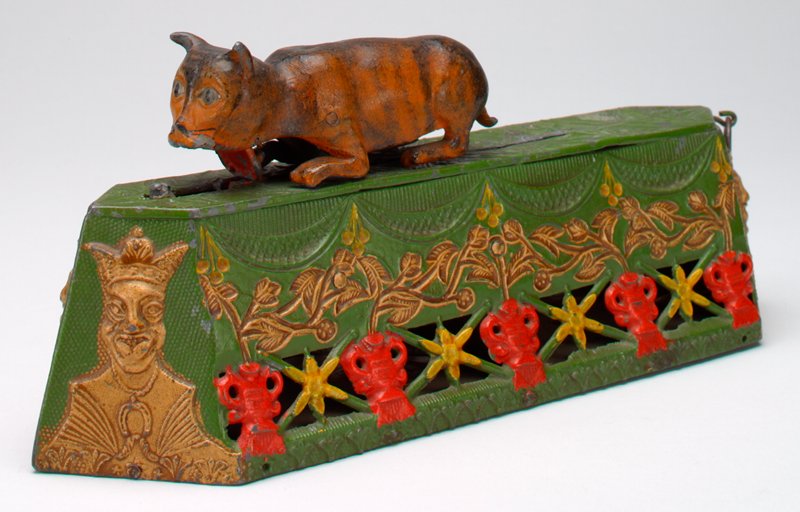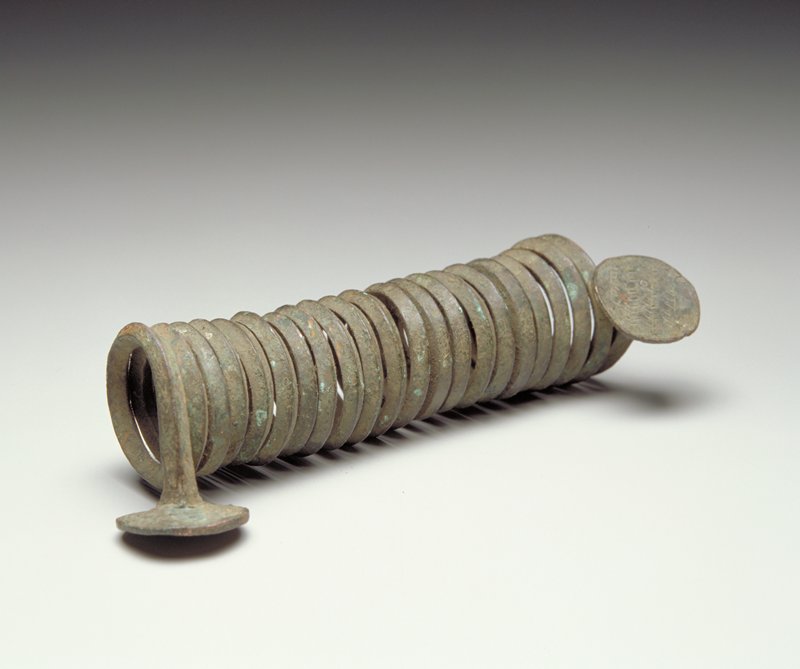Money and Trade
Spending and saving through times and places.
Idea One: Saving Your Pennies

Hall’s Excelsior or Cashier Bank mechanical bank, 1869
Iron, wood, pigment
Minneapolis Institute of Art
Gift of Katherine Kierland Herberger
Personal money-boxes and coin banks have been used to save and store coins by people around the world for hundreds of years. So it’s not surprising that when the United States of America distributed the first U.S. copper pennies in 1793, manufacturers began to produce special containers, called penny banks. Made as children’s toys, these banks taught youngsters a valuable lesson, the importance of saving money.
Mechanical banks of all shapes and sizes included models of animals, clowns, trains, safes, and children at play. All were fun to play with, but the mechanical banks rewarded the child who deposited a coin with an entertaining stunt. This building-shaped bank performs at the pull of a string, causing a monkey seated at a desk to pop out of the building’s roof. If one places a coin on the desk, the monkey quickly falls back into the bank, taking the coin along with it.
By the early twentieth century many people were collecting these artful and entertaining penny banks. One such collector was a woman named Katherine Kierland Herberger, who lived in Minnesota. She first purchased a bank for her son’s birthday, triggering a lifetime of collecting more than 1,000 banks.

Girl Skipping Rope mechanical bank, 1890,
Iron, pigment, Minneapolis Institute of Art,
Gift of Katherine Kierland Herberger
A girl skips rope when a deposit is made to the squirrel.

Lead, pigment, wood,
Minneapolis Institute of Art,
Gift of Katherine Kierland Herberger
A game of cat-and-mouse makes money fall into this mechanical bank

Fire Proof, still bank, 1906,
Tin, pigment,
Minneapolis Institute of Art,
Gift of Katherine Kierland Herberger
This bank in the form of a safe looks like a secure place to deposit coins.
Idea Two: Balancing a Budget

Balance, early seventeenth century
Huang-hua-li hardwood and pai tung hardware
Minneapolis Institute of Art
Gift of Ruth and Bruce Dayton
These metal scales were used to weigh silver for purchasing goods and services.
Two drawers in the wood stand kept the metal scales and weights safe when not in use.
Handles on the drawers are shaped like the finger citron (also known as Buddha’s Hand), a popular lemon-like fruit grown in Asia that was a Chinese symbol of good fortune.
This 400-year-old Chinese balance, made up of a large wooden stand, two metal scales, and a set of ten metal weights, was designed and operated during a time period called the Ming dynasty. At this time in China, small silver ingots, pieces of shaped metal, functioned as currency. This silver money was called sycee(SIGH-see).
Only the most special furnishings were made from the Huang-hua-li wood, its name meaning yellow flowering pear. The carefully handcrafted wood balance stand has two drawers for storing the metal scales and the set of weights when not in use. Because the stand and its equipment were heavy, they would have been difficult to move. Decorative metal reinforcements supported the wood frame, likely carried by its top rail.
Value was determined by weighing the sycee against the balance’s metal weights hanging on the scales. The metal weights, like the sycee, were formed into ingots of boat or shoe-like shapes symbolic of wealth.
A shopkeeper may have used this balance when selling goods and services to customers. Or perhaps it belonged to an estate manager who distributed wages to workers, allowances to family members, and payments to traveling merchants. As silver money was replaced by coin and paper currencies, balances faded into history and few hardwood balances like this one remain.
Idea Three: A Seaside Sale

Selling Fish, 1792
Oil on canvas
Minneapolis Institute of Art
Gift of the Paintings Council
A dog oversees the fresh catch of a large fish and a stingray.
A customer on horseback pays for his purchase with a coin.
The fishermen on this boat brave the stormy sea to make their living.
In the late 1700s, people in England were fond of images showing genre scenes (pictures of everyday people and places). Because it is an island nation, England enjoys a strong seafaring heritage. The sea was one of British artist George Morland’s favorite subjects.
In this painting, called Selling Fish, Morland shows the rugged coastline of England’s Isle of Wight. Hungry seagulls soar overhead, while in the distance boats steer through the waves as dark clouds pass in the sky along the shore. In the foreground a woman has laid out an assortment of goods. To her left, the boat pulled ashore suggests the new arrival of her wares. A man on horseback has come to the seaside, basket in hand, to purchase freshly caught fish. Perhaps he has selected the stingray, which the woman points to, as he hands her a coin in payment.
Although Morland’s artwork was popular and sold well in his day, the artist was foolish with his own money. In order to maintain his extravagant lifestyle, he needed to produce artwork constantly. Eventually his careless spending habits landed him in debtor’s prison, but he is nevertheless considered to be among the most talented British painters of his time.
Idea Four: Traded Treasures

Ketoh, 1920
Silver, leather, and turquoise
Minneapolis Institute of Art
Bequest of Virginia Doneghy
The Navajo (Dine) of the southwest United States did not hide their money in their pockets or in a bank during the mid-nineteenth century. Instead, they adorned themselves with their wealth. Having learned to work with silver, the Navajo put their savings into the creation and purchase of objects such as buttons, bracelets, rings, necklaces, and belts. These beautiful adornments, made with valuable metals and stones, became symbols of status as well as a form of currency.
With the opening of trading posts in 1870, Native Americans were able to trade their harvested crops, wool, and livestock for basic necessities and luxury goods. If a customer did not have enough products for trading, he or she could pawn jewelry for credit at the trading post. Traders took the jewelry in exchange for the needed goods. Later, the customer could bring in products with which to buy back his jewelry. Although traders were required by the government to hold onto the pawn for only one month, some held it much longer to help loyal customers. But sometimes traders took advantage of customers by selling their jewelry for less than its value. Therefore, many customers lost their valuables because the items were quickly sold.
Eventually, other Native Americans in the area, such as the Zuni (A’shiwi), took up silversmithing. Both Navajo and Zuni have created distinctive silver traditions. Although Southwestern jewelry is still produced for sale, the trading post system was replaced with the cash system we know today.

Silver, turquoise,
Minneapolis Institute of Art,
Bequest of Virginia Doneghy
Zuni (A’shiwi) silversmiths are known for their detailed and complex designs.
Idea Five: Objects of Value

Currency, 20th century
Copper
Minneapolis Institute of Art
The Christina N. and Swan J. Turnblad Memorial Fund
This heavy currency bracelet is made up of carefully twisted copper bands.
Throughout Africa’s history, items such as shells, beads, salt, cloth, gold and metal jewelry, weapons, and tools were used as currency in trade. Because many diverse cultures populated the vast expanse of Africa, people needed to agree on consistent values for currency objects. This meant currency had to be made from materials prized by all, and commonly accepted in trade. Additionally, careful craftsmanship and thoughtful artistry could increase the value of the currency objects.
While smaller objects, such as shells and beads, were used to carry out necessary everyday purchases and changed hands often, larger objects, like this copper currency bracelet from Nigeria, were reserved for more significant transactions. Special occasions and important life events such as a birth, death, or marriage involved the exchange of wealth.
Currency in the form of jewelry was prized because it could be worn as a symbol of status, representing the wealth of a family. It was valued not only for its material worth but also for the quality of its design. Every piece of currency created by a metal worker was unique and demonstrated the skill and craftsmanship of its maker. Jewelry was often custom fit to the wearer’s body. Although these objects are no longer traded as currency, they continue to be valued today for their substance and beauty.

Igbo
Copper
Gift of The Christina N. and Swan J. Turnblad Memorial Fund
Currency vary in size and value. Africa, Ibo, Currency, 20th century, Copper, Minneapolis Institute of Art, The Christina N. and Swan J. Turnblad Memorial Fund

Igbo
Copper
Gift of The Christina N. and Swan J. Turnblad Memorial Fund
Bracelets and anklets were a convenient way to store and transport wealth

Currency, date unknown,
Bronze, copper,
Minneapolis Institute of Art,
Gift of Ousman Kabba
Related Activities
Money Talks
Coins and bills as well as other objects used as currency can provide insight about their places of origin. Imagine you are an archaeologist living in the year 4008. You know little of the world we live in today. While working in North America you dig up a U.S. penny. What can this coin tell you about the country that once used it? Take a look at the images, writing, shape, and size of a penny. Write an essay explaining what this penny can tell you about our country and our times.
In Mint Condition
Visit the United States Mint Web site H.I.P. (History In your Pocket) Pocket Change, designed for interactive student learning about the history of American coins. Take a virtual tour of the United States Mint or travel back in time to spend your pocket change.
Making Money
Design your own currency in the form of a coin, bill, or other valuable object. Tell your classmates how the value of your currency would be determined and what it might be traded for.
Coin Collection
Make your own collection of coins. Take a look at mint years to see when your money was made. How have your coins changed or stayed the same through the years? Take a look at the history of U.S. coins and currency at the Smithsonian National Museum of American History’s online exhibition Legendary Coins and Currency.
See for Yourself
Take a closer look at penny banks at the Minneapolis Institute of Art. A rotating exhibition highlights selections of the Katherine Kierland Herberger penny bank collection. On view in Gallery 110. Admission is free.
Priceless Prose
Spend some time expanding your knowledge about currency. Take a look at these valuable books.
Bendick, Jeanne. How Much and How Many: The Story of Weights and Measures. New York: Franklin Watts, 1989.
Burns, Peggy. Stepping Through History: Money. New York: Thompson Learning, 1995.
Cribb, Joe and Laura Buller. Money (DK Eyewitness). DK Children, 2005.
Geography Department. Sold! The Origins of Money and Trade (Buried Worlds). Runestone Press, 1994.
Kummer, Patricia K. Currency (Inventions that Shaped the World). Franklin Watts, 2005.
Maestro, Betsy and Guilio Maestro. The Story of Money. HarperTrophy, 1995.
Standish, David. The Art of Money: The History and Design of Paper Currency from around the World. Chronicle Books, 2000.”
